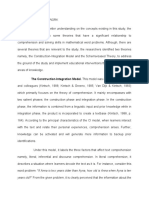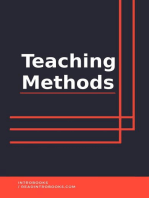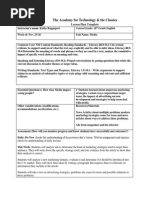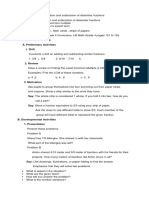Running Head: Mathematics, Education Theories and Technology 1 1
Running Head: Mathematics, Education Theories and Technology 1 1
Uploaded by
api-326620154Copyright:
Available Formats
Running Head: Mathematics, Education Theories and Technology 1 1
Running Head: Mathematics, Education Theories and Technology 1 1
Uploaded by
api-326620154Original Title
Copyright
Available Formats
Share this document
Did you find this document useful?
Is this content inappropriate?
Copyright:
Available Formats
Running Head: Mathematics, Education Theories and Technology 1 1
Running Head: Mathematics, Education Theories and Technology 1 1
Uploaded by
api-326620154Copyright:
Available Formats
Running head: MATHEMATICS, EDUCATION THEORIES AND TECHNOLOGY
Mathematics, Education Theories And Technology In Action
Yurby Rivas Barrera, Kristen Callender, Nicholas DiLauro and Saira Khan
MATHEMATICS, EDUCATION THEORIES AND TECHNOLOGY IN ACTION
Alliant International UniversityAbstract
Our project seeks to use technology tools to apply a number of educational theories to a series of
four lesson plans which target a specific Common Core State Standards (CCSS), (Common Core
State Standards, 2010) mathematics topic. Each of the lesson deals with characteristics of linear
equations and graphs and applies a number of principles and techniques from educational
theories. Among the theoretical techniques used are First Principles of Instruction (Merrill, 2002)
and Reducing Cognitive Overload which appear in the first lesson; Learning by Design (LBD),
(Georgia Institute of Technology, n.d.), Problem Based Learning (PBL), Case Based Reasoning
(CBR), (Kolodner, Hmelo & Narayanan, n.d.), Teaching Agents and Learning by Teaching
(LBT) (Leelawong & Biswas, n.d.), which appear in lesson two; gaming and simulation in lesson
three; and data analysis and virtual communities in lesson four. Aspects of situated cognition
(Brown, Coolins & Duguid, 198), anchored instruction (The Cognition and Technology Group at
Vanderbilt, 1990 and goal based scenarios (GBS) (Schank, 1992) were included in a number of
the lessons. We concluded that the application of educational theories to a specific topic, while
not the ideal way to approach educational principles, was at least a way to enrich content, engage
students and align learning with activity.
Keywords: Common Core State Standards, educational theories, learning by design, problem
based learning, case based reasoning, teaching agents, learning by teaching, data analysis, virtual
communities, situated cognition, anchored instruction, goal based scenarios
MATHEMATICS, EDUCATION THEORIES AND TECHNOLOGY IN ACTION
Mathematics, Education Theories and Technology in Action
For our project we created a series of lesson plans for 8th grade algebra centered on a
single general topic, linear equations and their graphs. Each lesson used technology tools to
apply educational theories while at the same time supporting specific Common Core State
Standards (CCSS), (Common Core State Standards, 2010). We wanted to see what challenges
would be encountered using a predetermined general topic and then finding opportunities to
apply new educational theories and principles to a particular concept within the topic area. We
saw this as a realistic approach to learning theories. Often it is possible to find a topic which fits
a particular theory or even find an activity which supports a particular theory and then allow the
content learned to evolve from this activity. However, it is often much more difficult to be
confronted with a required topic and then search for ways to apply more progressive approaches
to learning. This latter approach is the pathway we chose. The first lesson presents the concept of
slope and the slope-intercept form of the linear equation in a flipped and blended lesson plan
while incorporating some of the main ideas of the first principles of instruction and social
cognitive theory. It also makes use of media to reinforce some of these ideas. The second lesson
uses learning by design and goal based scenario theory to present linear graphing. The third
lesson uses gaming and simulation to address the process of deriving a linear equation from two
points on the line. The fourth lesson seeks to incorporate communities of practice, social
networking and data analysis into a lesson activity which challenges students to collect, analyze
and present data as linear graphs and equations. Finally, the theories of anchored instruction and
situated cognition were addressed in aspects of all four lessons. In each of these lessons we
strove to highlight specific educational theories while maintaining an underlying subject matter
closely aligned with standards. At the same time we reflected on how various theories and
techniques might enhance previous lessons. We did not overlook the possibility of using previous
MATHEMATICS, EDUCATION THEORIES AND TECHNOLOGY IN ACTION
theories and techniques as we explored new ones. It is hoped that this will provide a continuity of
purpose in the lessons and encourage a high level of student engagement. Rather than seeing the
various theories as distinct self-contained entities, we saw them more as a palate from which we
could blend the colors to achieve an organic and meaningful array of lessons.
The first lesson incorporates some of the first principles of instruction identified by
Merrill (Merrill, 2002), elements of which are found in a wide selection of teaching theories, to
address the subject of linear equations. Merrill identifies four principles of learning which work
together to solve a problem. These principles are activation, demonstration, application and
integration. Activation involves using prior knowledge to reinforce new knowledge. This was
accomplished in the lesson by integrating the circumference to diameter ratio into a linear
equation lesson. Students will see that the relationship between various circumferences of a
circle to their respective diameters is a linear one, i.e., the rate of change or slope is constant (pi).
Demonstration is used in the pre-lesson by providing links to videos which explain some of the
prerequisite knowledge for the lesson. The demonstration phase is also present in the lesson itself
and will depend on some of the activation derived from the pre-lesson. Application plays a part
in the problem solving portion of the lesson wherein students are asked to apply what they have
learned from the demonstration and pre-lesson. Finally, integration is achieved by linking the
pre-lesson, demonstration, and application phases to a classroom activityplotting the
relationship of the circumference to the diameter. The lesson also employs the self-efficacy
which Bandura (Bandura, 2001) sees as an important facet of the learning process. For example,
in this lesson the activity of graphing measured circumferences and diameters is error prone due
to the limitations of the measuring technique. Nevertheless, a general pattern emerges which
demonstrates the concept and hopefully reinforces student self-efficacy by taking the focus off
MATHEMATICS, EDUCATION THEORIES AND TECHNOLOGY IN ACTION
the inaccuracies and instead showing how they contribute to an accurate understanding of the
concept. Use was also made of the nine ways to reduce cognitive overload as described by
Mayer and Moreno (Mayer & Moreno, 2003). Pre-training is an essential element of the flipped
lesson. Segmenting was taken into account to by dividing the lesson into various phases. Offloading was used to divide the lesson between visual and auditory. Also, class slides were
examined to achieve alignment. While not a perfect application of the theoretical principles
discussed, the lesson was able to make use of some of the underlying techniques to enhance a
defined concept.
Learning by Design and the use of Teaching Agents were approaches to educational
theory which also challenged our topic driven approach. As was the case with other theories only
elements of these techniques could be incorporated into the second lesson plan. The goals of
problem-based learning (PBL) and its use of case-based reasoning (CBR), (Kolodner, Hmelo &
Narayanan , n.d.) are very challenging. Even the authors suggest blending this into a wellplanned curriculum over a period of time. They suggest using purposely complex, ill-structured,
and open-ended (Kolodner, Hmelo & Narayanan , n.d., p. 4) problems and offer ways of
managing the complexity using collaboration, coaching, tools for organizing their progress, and
scoping or scaffolding problems. Many of these ideas are similar to the principles introduced in
the previously discussed design theories. Learning by design (Georgia Institue of Technology,
n.d.) takes an even more open-ended approach by proposing design projects which challenge
students to experiment, collaborate, analyze, make decisions and develop complex skills. Ideally,
these types of environments require planning and time to execute properly and pose many
challenges to the student and teacher. If successful the knowledge gained is much more
transferable across disciplines because it is rooted in and stimulates the natural processes of
MATHEMATICS, EDUCATION THEORIES AND TECHNOLOGY IN ACTION
learning. Self-regulated learning (SRL) and Learning by Teaching (LBT), (LeelaWong &
Biswas, n.d.) were also methods which posed similar problems with regards to scope. However,
these techniques were more adaptable to a short, subject focused lesson plan. In our lesson plan
we sought to stimulate Learning by Design by giving students a somewhat open-ended
assignment. They are asked to create their own lesson plan using a poster board graph and
attachable lines to address three aspects of linear equations, the relationship of slopes of parallel
lines, the relationship of slopes of perpendicular lines and the effect of changes in the values of
the equations to the shift of the graph. This approach encourages Learning by Design and
collaboration as the students work together in their guided practice to refine their lesson plan
ideas. The teacher is available to serve as mentor to enhance the process, but allows the students
to drive the process. These elements are especially seen in the guided practice wherein they are
given a free range as to how to present their topic so long as it remains within certain constraints.
In the end the lesson plan provides a tangible approach to some complex characteristics of linear
equations and encourages student creativity and collaboration through the application of aspects
of the aforementioned theories. The subject central approach of our project posed similar
challenges as those encountered in other lessons, and this is further evidenced in the gaming and
simulation approaches which are addressed in the next lesson.
The third lesson which incorporates elements of games and simulation targets the CCSS
topic of finding a linear equation from two points using the slope and point-slope equations.
Kafai makes a distinction between instructionist and constructionist perspectives (Kafai, 2006).
An instructionist approach inserts the content into an activity whereas the goal of a
constructionist approach is to have the activity serve as a catalyst for the learning content. This
somewhat parallels Paperts (Papert, 1980) observation that computers in education could have a
MATHEMATICS, EDUCATION THEORIES AND TECHNOLOGY IN ACTION
QWERTY effect in that they could be a mode of perpetuating educational techniques which he
sees as detrimental to the learning process. This would be the instructionist pathway. His vision
is for simulation which enhances the natural learning process which parallels the constructionist
model. We saw many challenges to using the simulation and constructionist models since our
original paradigm was based on using a particular CCSS topic and applying educational theories
to lessons to it. We decided on using both the instructionist and constructionist approaches and
presented students with two sets of games in this lesson plan. The instructionist approach is seen
in the television style game which is just a container for classroom exercises. For the
constructionist approach we sought to create an original game which engaged student interest
through simulation. The spaceship rescue game falls short of many of the ideals of the
constructionist model, but it does include simulation elements which could help engage student
interest. The most valuable aspect of the games and simulation are that they spark student
competition, engagement and collaboration while at the same time presenting material which
otherwise might be perceived as rote. We reflected back to our video and media lesson plan and
saw that there were elements in it of what Papert described as activity which fosters the learning
of complex relationships. The comparison of the circumference to the diameters of circular
objects and the graphing of the relationship could lead to the sort of complex intuitions that
Papert saw occurring in his LOGO games. Similarly, the simulation game could lead students to
see other practical relationships that are linear. However limited, the lesson plan attempts to
combine two views of gaming and simulation towards the discrete topic of linear equations.
The fourth lesson adapted the principles of data collection and virtual communities to the
linear analysis of the circumference to diameter relationship. Data analysis is crucial to the
development of theories and new ideas. By paying close attention to patterns, the stories behind
MATHEMATICS, EDUCATION THEORIES AND TECHNOLOGY IN ACTION
outliers, relationships between and among data sets, and the external factors that may have
affected the data, students may come to have a deeper understanding of the crucial distinction
between theory and evidence, (Analyzinig Data, n.d.). In addition, this lesson plan incorporates
online sharing of data amongst students. The students use social media, Google+ , to share their
data with the whole class. These two techniques work together to arouse student engagement and
enhance their understanding of linear relationships.
The theories of situated cognition, anchored instruction and goal based scenarios had
similarities in the way they approached learning. All of them emphasized the need for an activity
which brings relevance to the information learned. In situated cognition, activity, concept and
culture work together to form the learning experience (Brown, Coolins & Duguid, 1989).
Anchored instruction emphasized the need for an activity to avoid inert knowledge and to
bring relevance to the knowledge (The Cognition and Technology Group at Vanderbilt, 1990).
Anchored instruction developed many of its concepts from situated cognition theory. Goal-based
scenario theory emphasizes the importance of goals as the root of human learning (Schank,
1992). All three acknowledged the importance of apprenticeship and building skill sets to
support the activity around which the learning centers. We sought to include elements of these
theories in all lesson plans. For example the gaming lessons presents the students with a specific
problem to solve in game format. The first and fourth lessons anchor the learning in the activity
of measuring, collecting and graphing data while the second lessons situates the learning in the
activity of creating a leaning board and accompanying lesson.
In all four lesson plans we attempted to stay closely aligned to a specific content and
apply principles of various educational theories. It was not too difficult to find applications of
linear equations which could be turned into activities, but it was harder to find activities which
MATHEMATICS, EDUCATION THEORIES AND TECHNOLOGY IN ACTION
would organically evolve into an understanding of linear equations. Having the constraints of
choosing a specific topic and the additional constraints of a traditional lesson plan forced a
adaptive approach which did not meet the ideals of many theories. Nevertheless, it is hoped that
the construction of lesson plans around specific activities helped to clarify difficult concepts and
at the same time engage student interest. Overall the application of the theoretical principles
served to enrich the content of lessons, and, as we progressed, we saw many opportunities to
combine principles from multiple theories into a single lesson. As a future study, it would be
valuable to evaluate these lesson plans in action and use the results to develop an activity which
spanned multiple lessons and which would allow a more organic unfolding of the concepts of the
linear equation within that activity.
MATHEMATICS, EDUCATION THEORIES AND TECHNOLOGY IN ACTION
10
References
Analyzing Data from Teacher Vision (2 pages).
Bandura, A. (2001). Social cognitive theory of mass communications. In J. Bryant, & D.
Zillman (Eds.). Media effects: Advances in theory and research (2nd ed., 121-153).
Hillsdale, NJ: Lawrence Erlbaum.
Brown, J.S., Collins, A., & Duguid, P. (1989). Situated Cognition and the Culture of
Learning. Center for the Study of Learning, University of Illinois at UrbanaChampaign.
Common Core State Standards, CCSS Copyright 2010 National Governors Association
Center for Best Practices and Council of Chief State School Officers. All rights
reserved.
Kafai, Y.B. (2006). Playing and Making Games for Learning: Instructionist and
Constructionist Perspectives for Game Studies. Games and Culture, 1(1), 36-40.
Kolodner, J.L., Hmelo, C.E., & Narayanan, N.H. (n.d.). Problem-Based Learning Meets
Case-Based Reasoning from The EduTech Institute College of Computing, Georgia
Institute of Technology. Learning by Design from the Georgia Institute of
Technology
Leelawong. K, & Biswas, G. (n.d.). Designing Learning by Teaching Agents: The Bettys
Brain System. Department of EECS/ISIS, Vanderbilt University.
Mayer, R. E., & Moreno, R. (2003). Nine Ways to Reduce Cognitive Load in Multimedia
Learning. Educational Psychologist, 38(1), 43-52.
MATHEMATICS, EDUCATION THEORIES AND TECHNOLOGY IN ACTION
11
Merrill, M. D. (2002). First principles of instruction. Educational Technology Research and
Development, 50(3), 43-59. Papert, S. (1980). Mind-storms: Children, computers, &
powerful ideas. Cambridge, Massachusetts.
Schank, Roger, C (1992). Goal-Based Scenarios
The Cognition and Technology Group at Vanderbilt. (1990). Anchored Instruction and
Relationship to Situated Cognition. Educational Researcher, 19(6), 2-10.
You might also like
- Project-Based Learning in the Math ClassroomFrom EverandProject-Based Learning in the Math ClassroomRating: 5 out of 5 stars5/5 (1)
- Applying Learning Design Concepts To Problem-Based Learning: Macquarie University, AustraliaDocument10 pagesApplying Learning Design Concepts To Problem-Based Learning: Macquarie University, AustraliaalhanunNo ratings yet
- What Did Taiwan Mathematics Teachers Think of Model-Eliciting Activities and Modeling?Document9 pagesWhat Did Taiwan Mathematics Teachers Think of Model-Eliciting Activities and Modeling?arumNo ratings yet
- Grade Twelve Students Establishing The Relationship Between Differentiation and Integration inDocument15 pagesGrade Twelve Students Establishing The Relationship Between Differentiation and Integration inThavarajah SelvarajahNo ratings yet
- In Action: Penelope (Pep) Serow & Michaela InglisDocument7 pagesIn Action: Penelope (Pep) Serow & Michaela Inglisanca irinaNo ratings yet
- PR3 Sample Research PAperDocument11 pagesPR3 Sample Research PAperKristine CalunodNo ratings yet
- Australian Based SOLODocument16 pagesAustralian Based SOLOlau dashNo ratings yet
- Lesson Study With A Twist: Researching Lesson Design by Studying Classroom ImplementationDocument8 pagesLesson Study With A Twist: Researching Lesson Design by Studying Classroom ImplementationOshiro NanaNo ratings yet
- Mastery of Problem-Solving Skills of Grade 6: I. Context and RationaleDocument8 pagesMastery of Problem-Solving Skills of Grade 6: I. Context and Rationaleleo anthony reccionNo ratings yet
- 3.keynote (Dec.9) Koeno Gravemeijer NetherlandsDocument20 pages3.keynote (Dec.9) Koeno Gravemeijer NetherlandsLeidy Cristina CumbalNo ratings yet
- Effectiveness of Transmitter of Knowledge and Conventional Teaching Models On Secondary School Students' Achievement On Circle Geometry and TrigonometryDocument13 pagesEffectiveness of Transmitter of Knowledge and Conventional Teaching Models On Secondary School Students' Achievement On Circle Geometry and TrigonometryAnca NedelcuNo ratings yet
- Learning CycleDocument13 pagesLearning CycleFrissa Rizkihati PrastikaNo ratings yet
- BENLAC Module 4 Integrating New Literacies in The CurriculumDocument8 pagesBENLAC Module 4 Integrating New Literacies in The CurriculumJustine Vistavilla PagodNo ratings yet
- Teaching Domain and Range of Rational Functions Using Explicit Teachig A Lesson StudyDocument7 pagesTeaching Domain and Range of Rational Functions Using Explicit Teachig A Lesson StudyIOER International Multidisciplinary Research Journal ( IIMRJ)No ratings yet
- Roles and Characteristics of Problem Solving in The Mathematics Curriculum: A ReviewDocument19 pagesRoles and Characteristics of Problem Solving in The Mathematics Curriculum: A ReviewSarahNo ratings yet
- Principle-Based Design Development of Adaptive Mathematics Teaching Practices and Beliefs in A Knowledge Building EnvironmentDocument18 pagesPrinciple-Based Design Development of Adaptive Mathematics Teaching Practices and Beliefs in A Knowledge Building Environment黃裕成No ratings yet
- Teachers As Curriculum Leaders: A. PedagogyDocument14 pagesTeachers As Curriculum Leaders: A. PedagogySmp ParadoNo ratings yet
- PAEE ALE 2018 137 RevDocument9 pagesPAEE ALE 2018 137 RevLilian CamposNo ratings yet
- The Principle of Mathematical Induction: An Experimental Approach To Improving Awareness of Its MeaningDocument10 pagesThe Principle of Mathematical Induction: An Experimental Approach To Improving Awareness of Its MeaningRathinam K KrishnanNo ratings yet
- 4 Concepts in Algebraic Form Galley GramDocument19 pages4 Concepts in Algebraic Form Galley Gramrnyx6969No ratings yet
- Problem Based LearningDocument4 pagesProblem Based LearningmadhigurlNo ratings yet
- Constructivist Approach in PhysicsDocument12 pagesConstructivist Approach in PhysicsDoug SmithNo ratings yet
- Critical ReflectionDocument5 pagesCritical Reflectionapi-324853564No ratings yet
- Integrative ReviewerDocument6 pagesIntegrative ReviewerMargie MarianoNo ratings yet
- EDED11399 - Learning Management 4: Assessment Task 1Document16 pagesEDED11399 - Learning Management 4: Assessment Task 1Ethan MannNo ratings yet
- Models and Theories of Curriculum DesignDocument5 pagesModels and Theories of Curriculum DesignMarinaFds100% (2)
- 4th Grade - Problem Solving Using The C.U.B.E.S. Procedure: Group RolesDocument26 pages4th Grade - Problem Solving Using The C.U.B.E.S. Procedure: Group Rolesapi-288856174No ratings yet
- CritiqueDocument6 pagesCritique陈王山No ratings yet
- Applying 7E Inst Model PDFDocument12 pagesApplying 7E Inst Model PDFHusni MuhyirungNo ratings yet
- Self-Regulated Learning in The Mathematics ClassDocument10 pagesSelf-Regulated Learning in The Mathematics Classcss_saidNo ratings yet
- Solid MensurationDocument10 pagesSolid MensurationChris Paul Pre100% (1)
- Tec 516 Instructional Theory and Model EssayDocument6 pagesTec 516 Instructional Theory and Model Essayapi-413658727No ratings yet
- Wip A Visual Approach To Teaching and Learning The Concept of LimitDocument25 pagesWip A Visual Approach To Teaching and Learning The Concept of Limitloubna BoutayibNo ratings yet
- An Inquiry-Based Design Research For TeachingDocument27 pagesAn Inquiry-Based Design Research For TeachingMARTHA JOHANNA RODRÍGUEZNo ratings yet
- The Experience of Using A Cognitive Acceleration Approach With Prospective Primary Teachers From Three Chilean UniversitiesDocument10 pagesThe Experience of Using A Cognitive Acceleration Approach With Prospective Primary Teachers From Three Chilean UniversitiesCatalina Andrea Tamayo TejosNo ratings yet
- The Role of Attention in Classroom Practice: Developing A MethodologyDocument8 pagesThe Role of Attention in Classroom Practice: Developing A MethodologyFidel LopezNo ratings yet
- Sullivan Et Al An Instructional Model To Support Planning and TeachingDocument5 pagesSullivan Et Al An Instructional Model To Support Planning and Teachingapi-611328976No ratings yet
- Chapter 1Document8 pagesChapter 1Jawayria D. DitucalanNo ratings yet
- Approaches in Teaching Mathematics Part I.Document6 pagesApproaches in Teaching Mathematics Part I.Charis VasquezNo ratings yet
- Strategies in MATHEMATICS TEACHINGDocument5 pagesStrategies in MATHEMATICS TEACHINGamyrose baybayNo ratings yet
- Models of CR IntegrationDocument9 pagesModels of CR IntegrationAdrian0No ratings yet
- MajRESEARCH 19 (Chap.1-5)Document29 pagesMajRESEARCH 19 (Chap.1-5)Jammel ManzanillaNo ratings yet
- Project Based Learning and Learning EnvironmentsDocument8 pagesProject Based Learning and Learning EnvironmentsYunita Dwi FebriastutiNo ratings yet
- Difference in The Use of Fraction Representations by 6th-GradeDocument11 pagesDifference in The Use of Fraction Representations by 6th-GradeblowparachuteNo ratings yet
- Microlearning-Kerres 0Document17 pagesMicrolearning-Kerres 0Murat DumanNo ratings yet
- ChamberlinDocument27 pagesChamberlinPak NurNo ratings yet
- A Task Centered Instructional Strategy PDFDocument19 pagesA Task Centered Instructional Strategy PDFNurul Hasnyta HamsaniNo ratings yet
- Analisis ConclusionDocument7 pagesAnalisis ConclusionAnnisa RNo ratings yet
- "I Don't Think They Need Any Help With The Formula": Examining Elementary Preservice Teachers' Responses To Volume TasksDocument14 pages"I Don't Think They Need Any Help With The Formula": Examining Elementary Preservice Teachers' Responses To Volume TasksGonzalo ReitmannNo ratings yet
- Sinem Parlak Sinem Parlak Midterm Paper 89672 282988212Document8 pagesSinem Parlak Sinem Parlak Midterm Paper 89672 282988212api-644206740No ratings yet
- (202276807) (Tshikalange M) (Reflective Essay)Document3 pages(202276807) (Tshikalange M) (Reflective Essay)Maanda TshikalangeNo ratings yet
- Sample Paper ImradDocument9 pagesSample Paper ImradMarjorie MalvedaNo ratings yet
- Hands On Learning Module Fluid Mechanics and Heat Transfer Washington State UniversityDocument11 pagesHands On Learning Module Fluid Mechanics and Heat Transfer Washington State UniversityVej JuttNo ratings yet
- Journal of Research On Computing in EducationDocument5 pagesJournal of Research On Computing in Educationapi-3718445No ratings yet
- Results of A Teaching Experiment To Foster The Conceptual Understanding of Multiplication Based On Children's LiteratureDocument8 pagesResults of A Teaching Experiment To Foster The Conceptual Understanding of Multiplication Based On Children's LiteratureoscarguerrerocNo ratings yet
- JAYMAR BALIHON Research 2023Document24 pagesJAYMAR BALIHON Research 2023JAYMAR TALLEDO BALIHONNo ratings yet
- Chapter 1 EditDocument5 pagesChapter 1 Editjsalahid68No ratings yet
- Which Is Bigger April 10Document18 pagesWhich Is Bigger April 10Nur MazidahNo ratings yet
- Hilbert Et Al Worked Out ExamplesDocument9 pagesHilbert Et Al Worked Out Examplesapi-75736613No ratings yet
- 10th Grade EnglishDocument3 pages10th Grade Englishapi-233421924No ratings yet
- PR2 2023 2024Document4 pagesPR2 2023 2024brownNo ratings yet
- Ways of CopingDocument13 pagesWays of Copingarifudin100% (1)
- Sience 3 Cot 2Document4 pagesSience 3 Cot 2april bahalla100% (4)
- Construction Employee Evaluation FormDocument2 pagesConstruction Employee Evaluation FormRaik Construction and Supply Hr60% (5)
- Fact Finding TechDocument23 pagesFact Finding Techapi-3706009100% (1)
- Demo PlanDocument3 pagesDemo PlanjohnNo ratings yet
- Machine Learning Specialization CloudxLab PDFDocument12 pagesMachine Learning Specialization CloudxLab PDFBibek GuptaNo ratings yet
- Philippines' Civil Service Professional Reviewer Answer KeyDocument7 pagesPhilippines' Civil Service Professional Reviewer Answer KeyDennis Aldwin Aguilar67% (3)
- RPH3 SN T2 EngDocument2 pagesRPH3 SN T2 Engnorliza hadamanNo ratings yet
- HKU Essay ComparisonDocument2 pagesHKU Essay Comparison周可欣No ratings yet
- Christian Yuki JaraDocument23 pagesChristian Yuki JaraSteven DeitaNo ratings yet
- BOW English 10 Q1Document16 pagesBOW English 10 Q1Rheinjohn Aucasa SampangNo ratings yet
- WHLP - Business Mathematics-Week 7Document1 pageWHLP - Business Mathematics-Week 7Sharon May Javier100% (1)
- How To Motivate Students in The ClassroomDocument4 pagesHow To Motivate Students in The ClassroomSheeva AbenidoNo ratings yet
- Design PastelDocument63 pagesDesign PastelDanielle Joyce NaesaNo ratings yet
- Webinar Deck UC Berkeley Digital Transformation 13 05 2019Document20 pagesWebinar Deck UC Berkeley Digital Transformation 13 05 2019Mark Jason MinaNo ratings yet
- WHLP Week 7 8Document8 pagesWHLP Week 7 8Ron Tristan GuetaNo ratings yet
- Mind Your Errors: Psychological Science December 2011Document8 pagesMind Your Errors: Psychological Science December 2011Daniel EsquivelNo ratings yet
- Instructional Supervisory PlanDocument2 pagesInstructional Supervisory Planbagto4bagNo ratings yet
- Org MGT q2-w5-6 Final EgsDocument16 pagesOrg MGT q2-w5-6 Final EgsHeiyoungNo ratings yet
- L D Needs ReportDocument8 pagesL D Needs ReportMark Delos ReyesNo ratings yet
- Positive PsychologyDocument51 pagesPositive PsychologyirrianadazNo ratings yet
- Section 504 of The Rehabilitation Act of 1973: Grand Canyon University EAD-505Document13 pagesSection 504 of The Rehabilitation Act of 1973: Grand Canyon University EAD-505api-309737337No ratings yet
- Aa Observation Reflection BanksDocument4 pagesAa Observation Reflection Banksapi-379906779No ratings yet
- TEACHING ACROSS AGE LEVEL B EnnyDocument5 pagesTEACHING ACROSS AGE LEVEL B EnnyEhemzzTurobulAqdamNo ratings yet
- Creative Writing Module OutlineDocument6 pagesCreative Writing Module OutlineMary Jo Legaspi0% (1)
- Learning Progressions CCSSO 2008Document32 pagesLearning Progressions CCSSO 2008Brian Burnett100% (1)
- Stress Prsentation by DR Sikandar Ali KhanDocument40 pagesStress Prsentation by DR Sikandar Ali KhanbhailolaNo ratings yet
- Syllabus C19 - LEC01 - Fall 2023Document10 pagesSyllabus C19 - LEC01 - Fall 2023박정원No ratings yet

























































































